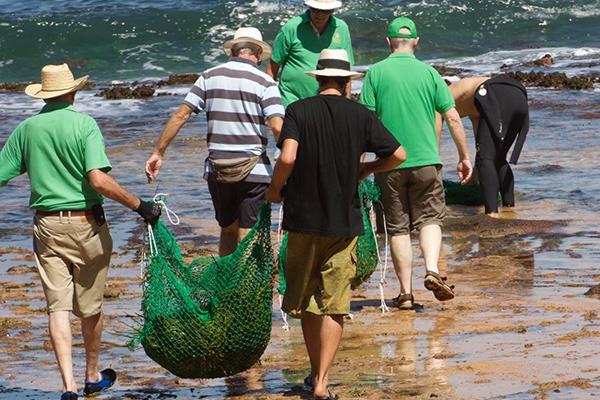
Plant trees, we’ll plant seaweed
By Parry Monckton, president-elect of the Rotary Club of Turramurra, New South Wales, Australia
In early March, members of my club joined the Operation Crayweed team at Mona Vale Beach to restore the denuded reef on the Sydney shore coastline. We decided to help plant a Crayweed forest as part of our unique response to RI President Ian Riseley’s challenge for Rotary members to plant trees around the world. Underwater trees, you see, are just as important, if not more so, to restoring the health and vitality of the world’s oceans.
Time and development have not been kind to the Sydney reefs. Pollution killed off a lot of the Crayweed before better sewage treatment and extended outfalls were put in place in the late 1980s. The quality fo water has improved dramatically. Unfortunately, seaweed forests do not return all by themselves. Enter Operation Crayweed, which has already had great success in eight sites around Sydney. The Mona Vale reef site will be the ninth seaweed forest planted.
Club members gather, measure, and record.
Club members gathered, measured, weighed, recorded and observed the quality of marine life on the individual kelp plants. These had been transported there from an earlier collection in the day from well-established reefs south of Sydney. Fifteen healthy plants were then put into each of nine pre numbered labelled green mesh bags then closed and fixed with cable ties. Three scuba divers from the University of New South Wales/Sydney Institute of Marine Sciences of Operation Crayweed (including leader, Dr ‘Ziggy’ Marzinelli and his team) floated them out from the beach to a predetermined reef site and anchored them down with clips and ropes with five preplaced stainless steel anchors to 45 bolts in the reef.
They were placed into about three to four meters of water, which took several. Our members were busily engaged in their scientific activities and sealing the mesh bags and carrying them to waiting divers. After repopulation of the reef, these nets and anchors will be removed.
The sites will now be revisited periodically. The Crayweed ‘forest’ that will emerge in the next 6 to 12 months will gradually take over the reef in coming years allowing the return of crayfish, fish, and all manner of other marine life to restore the natural underwater habitat lost in past years and for future people to enjoy.
Individual plants don’t have the effect a forest will, but clubs or members wishing to help can purchase these underwater “trees” to contribute to a future planting by contacting our club. Look at it as a way of responding to Riseley’s challenge if you wish. There is plenty of shoreline reef off of Sydney in need of restoration. Operation Crayweed will give us periodic updates on the health of the forest of weed.